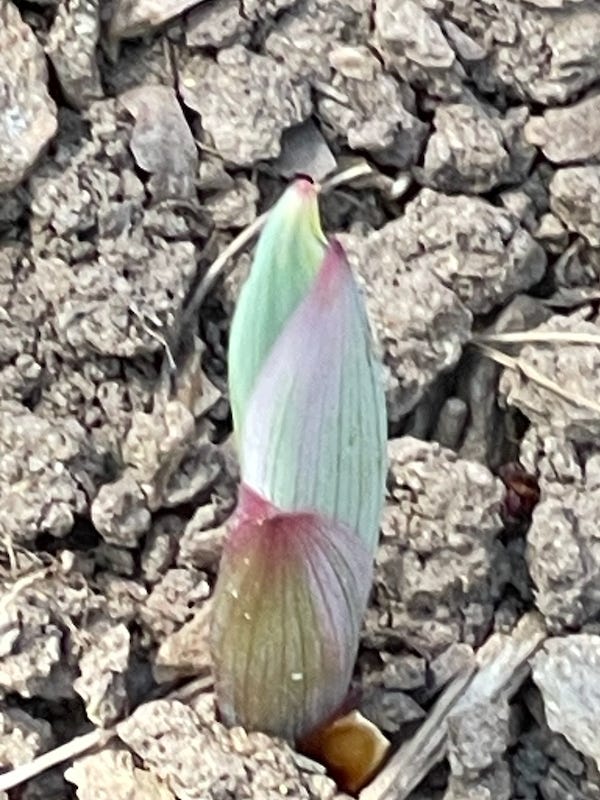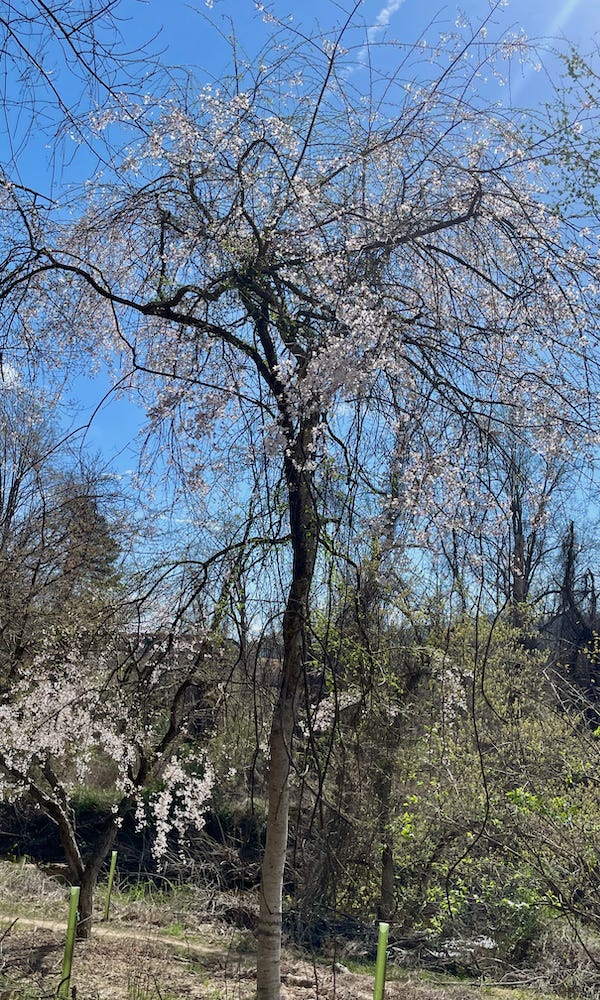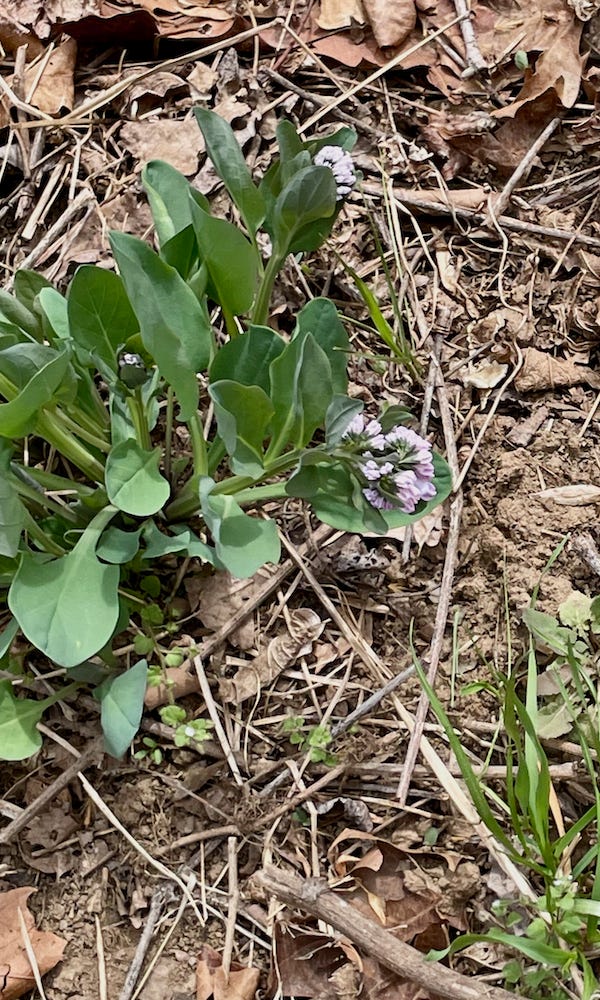Special Education Today newsletter 4(40)
What happened here at SET during the week beginning 24 March 2025?
Hello, Dear Readers, wherever you are. Here you have yet another issue of the Special Education Today newsletter, the 1250th post of SET. Thanks to those ~150 subscribers who have been along for the ride since the beginning (think of how many of your electrons I’ve wasted!) and welcome to the ~200 of you who have subscribed in the last year—thanks for letting me squander your electrons!
This issue of the newsletter has the usual contents. There is a photo section, status notes, a listing of posts from the previous few days, and an informative and compelling (I hope) editorial observation. And we’re off (and stumbling)!
Photo
We have started spring, at least by the calendar, here in the central mid-Atlantic region and, though the narcissi are fading, there are spring ephemerals to celebrate. I had a little local tour to examine newly emerging plants in our surrounds.
For assistance, I carried my phone with iNaruralist and Merlin; I also had the company of my local naturalist—it’s especially nice to have Pat pointing to tiny leaves that are unfolding close to the Earth and say, “That? Oh, that’s going to be a simmimamamamia pseudothisorthat flower. It’s introduced, not a native, but it’ll have lovely, little yellow blossoms.”1
Here are a three photos from the walk. I took them 30 March 2025. I’ve added links to resources from Virginia Working Landscapes, which is affiliated with the Smithsonian Institution, so that readers can learn more about the first and last plants in this list.
Solomon’s Seal
Solomon’s Seal is a lovely woodland plant one usually sees in parts of wood around our parts (but elsewhere, too). This little shoot is one of many poking through Earth in preparation for doing magic with water, nutrients, and sunlight so that it can add to is underground rhizome. I think Pat said she brought some of these from her garden at our previous home. My camera was very close to the shoot; it’s actually about the size of a short, thick little finger.

Cherry
Here’s a Cherry tree that’s pretty much in full bloom. The picture, which I didn’t enhance, doesn’t quite capture the shade of pink my eyes saw. It’s right about along our property line to the south-southeast of our house. (At the bottom left of the photo you can see the public trail that borders our property.)

Virginia BlueBells
These Virginia Bluebells are early in their bloom cycle, as I understand. There were a couple of other plants adjacent to this one, but I didn’t handle my camera well enough to get more than this one in the frame (and I cut off some of it!). If you follow the link to the Virginia Working Landscapes page, you’ll learn that they are “threatened,” so I’m tagging the image to alert those folks (@virginiaworkinglandscapes and #nativeplantwatch).

SET status
It is time for another DoT (Department of Thanks). I get the opportunity to express gratitude to folks who are new subscribers, commenters, and restackers.2
Patrons: As I have previously, I want to say “thank you” to Kathy M., Mike G., and Li-Yu H. for their super support of SET. I’m serious: If you’re out and about and you encounter one of these folks, please tell her or him, “Thanks.”
Welcomes: Tom, Breeze, Jamie C., Ed M. (again?!), Simmsu, Mandy R., Holly K., McKenna W., and multiple notices of new subscriptions with no user info…anonymous?…there were five or six of these this past week. I don’t know what’s up with them. I may have to contact support to determine why they are appearing as new subscribers. Anyway, yay for all the new folks!
Comments: Jane B., Sally B., and Jen W. (three times!) contributed. I find comments very encouraging. It’s so nice to know that I’ve rang a chime, and that yourDRs, are thinking about what I sat here and typed! Thank you, commenters for your interactions with the content.
There were ~3800 reads of posts on SET last week, which is down a bit from the ~9000 the previous week. For everyone who visited and read something, thanks. And please continue to share SET!
Last week’s posts
The previous week I published six posts on SET, which is fewer than usual. Here is a list of those posts, each linked to the original:
Special Education Today newsletter 4(40): What in the world is going on?
Communication barriers experienced by Canadian individuals with disabilities: What impediments do adolescents and adults encounter?
Selected notes about special education functions moving to a different US department: What's going on with "special needs" going to Health and Human Services?
Tom Zirpoli warning about parents of students with disabilities: Does he think that this group has ideas about demolishing US ED?
Frances Partridge Connor: Remembering an influential contributor to special education
Yes, I've been slack, and here's why (sorta): Where will you find me the week of 1 April 2025?
Remember that if you ever have missed a post, you can go directly to the Web site at https://www.SpecialEducationToday.com/ and see a catalog of all the posts—and, if you’re a paid subscriber, you can read the entire archive, each and every one of the > 1200 of them (including this one).
Comments
Well, DRs, I’m back on my diversity hobby horse this week. This may start to sound like a rant, and if my previous rants have made you uncomfortable, you might want to reflect on whether to read the next paragraphs…sigh.
I’ve heard a lot in the last few months about diversity, equity, and inclusion. Gaagle, bless it’s data-grabbing (and $$-grubbing) heart, provides a site that allows one to see time-series graphs showing how often (relatively) its search engine searches for given terms. As loathe as I am to recommend using Gaagle, readers might want to explore it. The data available provide an intriguing glimpse of what’s happening on Earth (or even subparts of Earth). For what terms are people searching? But we hardly need Gaagle Trends to know that “diversity, equity, and inclusion” has been a hot topic lately, at least in the US.
I fear, however, that many people whom readers of SET know in their workplaces, neighborhoods, families don’t think about DEI as including individuals with disabilities. DEI? That’s about Blacks, Hispanics, LGBTRSWz (or some letters), right?
But, disability is a dimension of diversity. We don’t need to go all the way into the neurodiversity movement to understand this idea. It’s obvious that there is variance in how people move about the environment, variation in what size letters, people can name, how clearly people speak common words, how many practice trails it takes for people to reach mastery of a skill, how vulnerable people are to slipshod instruction, etc. Individual differences along those (and other) dimensions are part of the basis on which we say that some students need special education.
So, those of us who are concerned about children and youths with disabilities and their education rightfully should be concerned about diversity, equity, and inclusion. I’d hazard a guess that just about every individual who reads SET regularly is among those who harbor such concerns. And I’d also hazard a guess that when the general public talks about diversity, equity, and inclusion, very many members of that public don’t think about disability. They think about other dimensions of diversity: race, ethnicity, country of national origin, language, and such.
This is not to say that those other dimensions of diversity do not merit consideration. I think we jolly well ought to be concerned about discrimination along the lines of classes protected in US federal law such as color, race, medical conditions, and disability3
Probably most of the readers of SET have anecdotes about discrimination against or derogation of individuals with disabilities. Some of us have
Seen shoppers who have no disability pull into a parking space clearly marked as reserved for handicapped patrons, saying, “Oh it’s OK. I’m just going to be a minute…and why should those people get all the best parking places?”
Had a hallway conversation with a local education agency official in which the conversation included something like, “You know how strapped Washington Schools is for funding. We can’t even pay you what you're worth. So, we just can afford to give that juvenile delinquent a Cadillac IEP.”
Heard a parent at a cocktail party say, “Oh, I wanted my kid to get extra time on tests, too, so I found a doctor who said she has ADHD, and now she’s getting legally guaranteed accommodations.”
Been at a sports venue and heard another person yell (with spittle flying), “Get a clue! Make the f’ing tackle, you retard!”
I think it is important for those of us who care about students with disabilities—and, by extension, individuals with disabilities in general—to speak up, to say (calmly but clearly), "I want everyone to note that children and youth with disabilities are a class of people for whom we should protect equity and inclusion.”
We should say it at elected representatives’ “town halls,” political candidates’ fora, school board meetings, city council comment sessions, coffee klatches, our family’s dinner gatherings…in our sleep.
In some geographic areas on the surface of Earth, we are experiencing turbulence in socio-political directions and plans. Regardless of where we live and what socio-political currents are buffeting us and our kids, we deserve to be marked as failures if we do not resolutely stand up for them.
In that vein, allow me to express my hopes that you are continuing to take care of yourselves and those close to you, including securing their safety and long-term security. And I hope that you are staying healthy and happy. And I hope that you teach your children well.
JohnL
John Wills Lloyd, Ph.D.
UVA Professor Emeritus
Founder & Editor, Special Education Today4
SET should not be confused with a product that uses the same name and is published by the Council for Exceptional Children. SET predated CEC’s publication by decades. Despite my appreciation for CEC, this product is not designed to promote that organization nor should the views expressed here be considered to represent the views or policies of that organization.
Footnotes
You know, knowing stuff is its own punishment. When you know shipload about flowers, then you camping near have to open the floodgates and tell what you know when someone asks about asters…or, say autism. I have flooded people at parties when they say, “Oh, special education…is that like learning disabilities?”
I’m not listing the Likers this week. There were lots of them and I’d be sifting and typing until after time for me to post this newsletter! Well… the time requirement is an exaggeration, but there were lots of likes; you can look back and see them.
According to Westlaw, there are 10 protected classes: color, religion or creed, national origin or ancestry, sex (including gender, sexual orientation, and gender identity), pregnancy, childbirth, and related medical conditions, age, physical or mental disability, veteran status, genetic information, and citizenship.
Yes, and I’m also the chief and only proofreader, so blame it on me. (But send me a note with corrections, please.)


John, I love the pictures of the plants/flowers. Spring flora are my favorite. One place I used to work had regular (weekly) one mile spring nature walks on their various 14 miles of natural trails so we could view and learn about all the signs of spring. Also, yes, yes, yes!!! I've been preaching the same message - people with disabilities (whether children, teens, or adults) are all part of DEI and we need to speak up for them as well as the other groups that fall into DEI. I've been seeing multiple pictures of a t-shirt that says "You are Probably DEI Too." on the front and on the back it lists all the different groups that fall into DEI. Unfortunately, I can't get the print large enough to see if people with disabilities are included on the list or not but I can see that the header above the list says "This isn't even a complete list". I'm planning to be part of a local protest on Saturday (my first one ever!) and will be including messages about special education and DEI on my sign (still trying to decide the exact design yet).